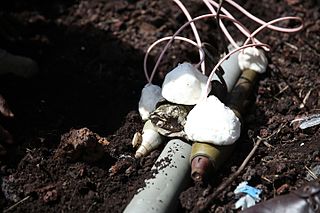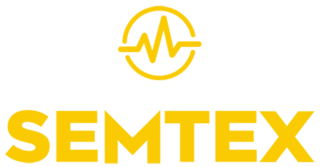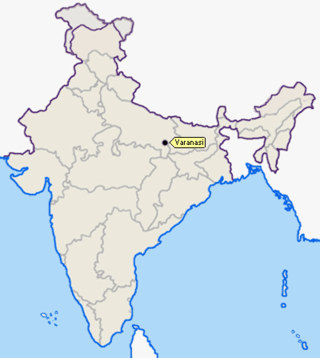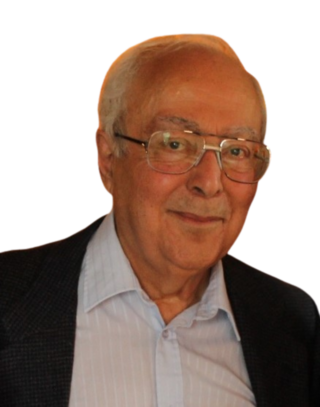
RDX (abbreviation of "Research Department eXplosive") or hexogen, among other names, is an organic compound with the formula (O2N2CH2)3. It is white, odorless and tasteless, widely used as an explosive. Chemically, it is classified as a nitroamine alongside HMX, which is a more energetic explosive than TNT. It was used widely in World War II and remains common in military applications.

An explosive is a reactive substance that contains a great amount of potential energy that can produce an explosion if released suddenly, usually accompanied by the production of light, heat, sound, and pressure. An explosive charge is a measured quantity of explosive material, which may either be composed solely of one ingredient or be a mixture containing at least two substances.

Plastic explosive is a soft and hand-moldable solid form of explosive material. Within the field of explosives engineering, plastic explosives are also known as putty explosives or blastics.

Pentaerythritol tetranitrate (PETN), also known as PENT, pentyl, PENTA, TEN, corpent, or penthrite, is an explosive material. It is the nitrate ester of pentaerythritol, and is structurally very similar to nitroglycerin. Penta refers to the five carbon atoms of the neopentane skeleton. PETN is a very powerful explosive material with a relative effectiveness factor of 1.66. When mixed with a plasticizer, PETN forms a plastic explosive. Along with RDX it is the main ingredient of Semtex and C4.

Pardubice is a city in the Czech Republic. It has about 92,000 inhabitants. It is the capital city of the Pardubice Region and lies on the Elbe River. The historic centre is well preserved and is protected as an urban monument reservation.

C-4 or Composition C-4 is a common variety of the plastic explosive family known as Composition C, which uses RDX as its explosive agent. C-4 is composed of explosives, plastic binder, plasticizer to make it malleable, and usually a marker or odorizing taggant chemical. C-4 has a texture similar to modelling clay and can be molded into any desired shape. C-4 is relatively insensitive and can be detonated only by the shock wave from a detonator or blasting cap.
Detasheet is a flexible rubberized explosive, somewhat similar to plastic explosives, originally manufactured by DuPont. Its ingredients are PETN with nitrocellulose and a binder.
A triggering sequence, also called an explosive train or a firing train, is a sequence of events that culminates in the detonation of explosives. For safety reasons, most widely used high explosives are difficult to detonate. A primary explosive of higher sensitivity is used to trigger a uniform and predictable detonation of the main body of the explosive. Although the primary explosive itself is generally a more sensitive and expensive compound, it is only used in small quantities and in relatively safely packaged forms. By design there are low explosives and high explosives made such that the low explosives are highly sensitive and high explosives are comparatively insensitive. This not only affords inherent safety to the usage of explosives during handling and transport, but also necessitates an explosive triggering sequence or explosive train. The explosive triggering sequence or the explosive train essentially consists of an 'initiator', an 'intermediary' and the 'high explosive'.
The Composition C family is a family of related US-specified plastic explosives consisting primarily of RDX. All can be moulded by hand for use in demolition work and packed by hand into shaped charge devices. Variants have different proportions and plasticisers and include composition C-2, composition C-3, and composition C-4.
A taggant is any chemical or physical marker added to materials to allow various forms of testing. Physical taggants can take many different forms but are typically microscopic in size, included at low levels, and simple to detect. They can be utilized to differentiate authentic product from counterfeits, provide identifying information for traceability purposes, determine mixing homogeneity and cross-contamination, and to detect dilution of proprietary products. Taggants are known to be widely used in the animal feed industry, plastics, inks, sheet and flexible explosives, and pharmaceuticals.

Ethylene glycol dinitrate, abbreviated EGDN and NGC, also known as Nitroglycol, is a colorless, oily, explosive liquid obtained by nitrating ethylene glycol. It is similar to nitroglycerine in both manufacture and properties, though it is more volatile and less viscous. Unlike nitroglycerine, the chemical has a perfect oxygen balance, meaning that its ideal exothermic decomposition would completely convert it to low energy carbon dioxide, water, and nitrogen gas, with no excess unreacted substances, without needing to react with anything else.

Explosive detection is a non-destructive inspection process to determine whether a container contains explosive material. Explosive detection is commonly used at airports, ports and for border control.
The Omnipol Group of companies is headquartered in Prague, the capital of the Czech Republic. Throughout the country the Omnipol Group employs 4000 people, out of which over 400 are dedicated to research and development.

Semtex is a brand of energy drink manufactured in the Czech Republic by Pinelli since 1995, and was the first such drink to be produced in the country. The drink gained notoriety after taking its name from Semtex, a well-known plastic explosive, which is also of Czechoslovak origin.

Česká zbrojovka is a Czech company producing forklifts Desta and components for the automobile industry, it is former firearms manufacturer, also known for making ČZ motorcycles. ČZ was established as a branch of the Škoda Works Armament in Strakonice, Czechoslovakia in September 1919.

Erythritol tetranitrate (ETN) is an explosive compound chemically similar to PETN, though it is thought to be slightly more sensitive to friction and impact.
Mononitrotoluene or nitrotoluene (MNT or NT), is any of three organic compounds with the formula C6H4(CH3)(NO2). They can be viewed as nitro derivatives of toluene or as methylated derivatives of nitrobenzene.
Explosive materials are produced in numerous physical forms for their use in mining, engineering, or military applications. The different physical forms and fabrication methods are grouped together in several use forms of explosives.

The 2010 Varanasi bombing was a blast that occurred on 7 December 2010, in one of the holiest Hindu cities, Varanasi. The explosion occurred at Sheetla Ghat, adjacent to the main Dashashwamedh Ghat, where the sunset aarti, the evening prayer ritual to the holy river, Ganges had commenced, on these stone steps leading to it, where thousands of worshipers and tourists had gathered. It killed a two-year-old girl, sitting on her mother's lap, the mother was one of three critically injured, more than 38 other people were injured. In the ensuing panic after the blast, a railing broke causing a stampede leading to an increase in the number of injuries. The bomb was hidden inside a milk container on the Sheetla Ghat. The blast occurred a day after the anniversary of the 1992 Babri Masjid demolition, in which a mosque was demolished at Ayodhya leading to nationwide religious riots killing over 2,000 people. Subsequently, the Islamist militant group, Indian Mujahideen, claimed responsibility of the blast, via email to Indian media. This is also the second terrorism-related incident in the city which was rocked by the serial blasts of 2006, in which 28 people were killed, it included an explosion at the Sankatmochan Temple, some two kilometres away.

Lorne Elias is a Canadian chemist, inventor, and a pioneer in explosives detection technology. He invented the explosives vapour detector, EVD-1, a portable bomb detection instrument deployed at international airports in Canada in the 1980s. He contributed to the field of explosives detection for over three decades, and is called the father of vapour and trace explosives detection technology.













